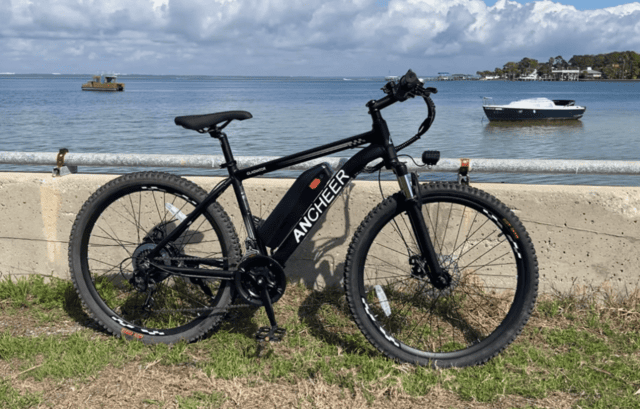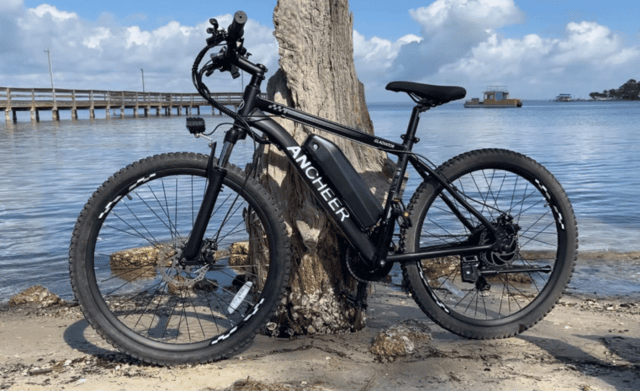Featured Summary
- Ancheer electric bikes deliver entry-level e-mobility at rock-bottom prices. Expect modest 350–500W hub motors (often “750W peak”), 36–48V batteries in the 374–499Wh range, and 20–22 mph top speeds—good for flat-to-mild hills and short-to-medium commutes.
- Current listings emphasize UL 2849 certification on many models and a 1-year warranty, but buyers should double-check model-specific safety labels and be aware of a 2022 battery recall that affected an older model (AM001907).
- If you’re budget-focused and mechanically handy, Ancheer can be fine value; if you want stronger support, components, or range, consider spending more.
Introduction
Shopping for a budget e-bike and seeing Ancheer everywhere? This review explains who Ancheer is for, how their bikes ride, the specs you’ll actually get, known safety/warranty notes, and a quick model comparison so you can decide with confidence.

Brand at a Glance
Ancheer is a value-oriented brand selling online (its own store and major marketplaces). Current lineups include mountain, city/commuter, folding, fat-tire, and even a 3-wheel option, generally priced around $300–$800 during frequent promotions. The spec pattern is consistent: rear hub motors, mechanical disc brakes, basic cadence-sensor PAS, and removable batteries. Top speeds commonly list 20–22 mph (Class-2-like performance with throttle).
Price–Spec Reality
- Motors: 350W–500W rated (often advertised 750W peak).
- Batteries: 36V/374Wh to 48V/499–520Wh; claimed ranges of ~30–60 miles depending on assist.
- Speeds: 20–22 mph on most models; some fat-tire versions quote up to 25–28 mph (check local laws).
Safety & Certification: What to Know
- UL 2849: Multiple current product pages state “UL 2849 certified by SGS” for the complete e-bike. You should still verify the UL mark on the actual bike/label for your exact model/production run.
- Historical Recall: In October 2022, the CPSC announced a recall of Ancheer batteries used with model AM001907 due to fire/explosion risk. Affected owners were instructed to stop using that battery and contact the brand for a replacement. This recall does not automatically apply to every current model, but it’s a relevant part of Ancheer’s history.
Bottom line: If safety is your top priority, favor models clearly marked UL 2849 on-bike and on documentation, and buy from channels that honor returns/warranty.
Warranty, Returns & Support
Ancheer’s site lists a 1-year warranty and 30-day returns/exchanges for quality issues. Verify the exact terms on the product page and keep proof-of-purchase. Like most budget brands, support can vary by channel; buying directly from the brand may streamline warranty service.

How It Rides (Performance & Use Cases)
For commuting, campus rides, and errands on mostly flat terrain, Ancheer’s cadence-sensor PAS feels simple and predictable. The hub motor gets you to 20 mph comfortably, and mechanical discs are fine for moderate speeds if kept adjusted. On steeper hills or heavier riders, expect slower climbs; these are not torque-sensor, mid-drive hill crushers. Battery capacities around 374–499Wh translate to ~15–25 miles throttle-heavy or ~25–45 miles in PAS for many riders—close to the brand’s claims in gentle use.
Build & Components
Expect aluminum frames, entry-level suspension forks, basic LCDs, Shimano 21-speed drivetrains on some MTBs, and wired throttles. Assembly typically arrives ~85% complete; plan a careful setup at home or a bike-shop tune for best results.
Who Ancheer Fits Best
- First-time e-bike buyers testing the waters on a tight budget.
- Students/commuters needing short daily rides on mostly flat routes.
- DIY-inclined riders comfortable with minor adjustments and routine maintenance.
Who should look elsewhere? Riders who want longer range, higher-end components, torque sensors, or rock-solid dealer support may be happier stepping up in price.
Quick Compare: Popular Ancheer Models (2025)
| Model | Motor (rated / peak) | Battery (Wh) | Top Speed | Claimed Range | Wheel/Tire |
|---|---|---|---|---|---|
| AN5928 “Fawn” step-through city | 500W peak listed | 48V 7.8Ah (≈375Wh) | 22 mph | Up to 45 mi | 26″ city |
| AN5856 26″ MTB (TotGuard-branded on site) | 350W (500W peak listed) | 36V 374Wh | 19.8–20 mph | 28–45 mi (mode-dependent) | 26″ MTB |
| AN5942 “Wooken” 20×4″ folding fat-tire | 500W (750W peak) | 48V 10Ah (≈480–499Wh) | 20 mph | Up to 60 mi | 20×4″ fat |
Specs pulled from current product/collection pages; check your exact SKU for final on-bike labels.
Pros & Cons
Pros
- Ultra-low prices with frequent discounts.
- UL 2849 messaging on several current models (still verify on delivery).
- Broad style variety (city, MTB, folding, fat-tire, even trike).
Cons
- Entry-level components and basic ride feel vs. pricier brands.
- Past battery recall on specific older model (AM001907) demands buyer diligence.
- Support varies; warranty is 1 year, shorter than some competitors.
Buying Tips (Checklist)
- Confirm certification: Look for a UL 2849 mark on the bike or in the user manual for your exact model.
- Run the VIN/label: If buying used/older stock, check recall information for the AM001907 battery notice.
- Right-size the battery: For daily 10–15 mile round-trips with some throttle, aim at ~480–500Wh packs.
- Plan a first-service tune: A basic shop tune after break-in keeps mechanical discs and shifting dialed.
- Keep receipts: Needed for that 1-year warranty and returns.
Alternatives to Consider
If you can stretch the budget, moving to brands with longer warranties, dealer networks, or torque sensors will improve ride quality and support. But if the target is lowest cost per mile with simple maintenance, Ancheer remains one of the most visible options online.
Here is a video explaining the product: